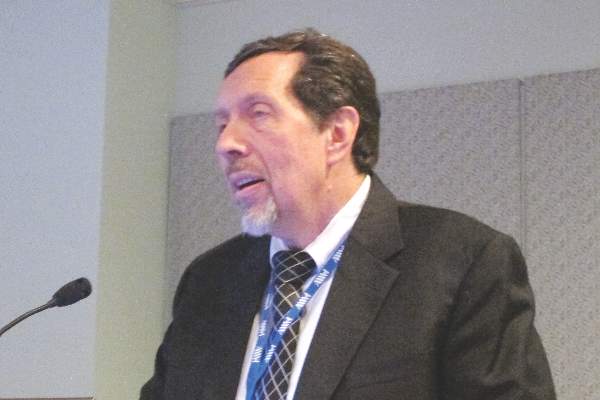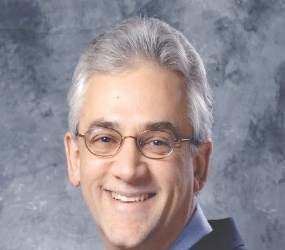AT 2016 AAAAI ANNUAL MEETING
LOS ANGELES (FRONTLINE MEDICAL NEWS) – The interleukin-5 inhibitor reslizumab showed particularly strong efficacy in patients with severe eosinophilic asthma accompanied by chronic sinusitis and nasal polyps, as well as in patients age 65 and older, in separate analyses presented at the annual meeting of the American Academy of Allergy, Asthma, and Immunology. Both presentations were post hoc, pooled analyses of two published 52-week, double-blind, pivotal phase III randomized trials of IV reslizumab at 3.0 mg/kg or placebo every 4 weeks on top of standard background therapy. The trials included a combined total of close to 1,000 patients aged 12-75 years with baseline blood eosinophil counts of at least 400 cells/mcL and inadequately controlled asthma despite being on at least moderate-dose inhaled corticosteroids. The primary endpoint – frequency of clinical asthma exacerbations – was positive in both trials, with a reduction of 54% with reslizumab compared to placebo ( Lancet Respir Med. 2015 May;3[5]:355-66 ).
Reslizumab is a humanized monoclonal antibody of the IgG4/K isotype. On the basis of the phase III trials and other data, last December the Food and Drug Administration’s Pulmonary-Allergy Drug Advisory Committee voted 11-3 to recommend approval of the biologic in 18- to 75-year-olds with inadequately controlled eosinophilic asthma. A decision by the federal agency is expected imminently.
The two post hoc analyses were conducted to highlight the biologic’s performance in clinically important but previously understudied patient subgroups, according to investigators.
Dr. Steven F. Weinstein compared 52-week outcomes in 250 patients with chronic sinusitis, including 150 who also had nasal polyps, in juxtaposition to the total two-study population of 953 eosinophilic asthma patients. Of note, aspirin sensitivity was present in 37% of those with chronic sinusitis with nasal polyps (CSwNP) compared to 11% of total participants in the two phase III trials. The CSwNP group had higher blood eosinophil levels, too: an average of 884 cells/mcL, compared with 655/mcL in the study population as a whole.
The frequency of clinical asthma exacerbations was 3.22 episodes in 52 weeks in CSwNP patients on placebo and 0.56 in those given reslizumab, for an 83% reduction in the active treatment arm. In the overall study population, the frequency was 1.81 episodes with placebo versus 0.84 with reslizumab, for a less robust but still highly significant 54% reduction. The reduction in exacerbations among all subjects with chronic sinusitis who received reslizumab was intermediate at 70%, going from 2.81 episodes in controls to 0.83 with biologic therapy.
Clinical asthma exacerbations were defined as the use of systemic steroids by patients not already on such medication or at least a twofold increase in doses of inhaled or systemic corticosteroids for at least 3 days.
The placebo-subtracted improvement in lung function from baseline to 52 weeks in reslizumab-treated patients was 326 mL in the CSwNP group, 235 mL in all patients with chronic sinusitis, and 109 mL in the overall study population, according to Dr. Weinstein, an allergist-immunologist practicing in Huntington Beach, Calif.
A 0.5-point improvement on the validated Asthma Quality of Life Questionnaire (AQLQ) is accepted by researchers as the minimum for demonstrating clinically significant benefit. The 52-week placebo-subtracted improvement on this measure was 0.69 points in the reslizumab-treated CSwNP group, 0.47 in the total cohort of asthmatics with chronic sinusitis, and 0.27 points in the overall reslizumab-treated population.
Similarly, the average placebo-subtracted improvement on the Asthma Control Questionnaire–6 was 1.45 points in reslizumab-treated patients with CSwNP, a sixfold greater response than seen in the total study population, Dr. Weinstein noted.
The same pattern of greater-than-average efficacy on both primary and secondary study endpoints was seen with reslizumab in the 77 patients aged 65 years and older included in the two phase III trials compared with those age 18-64, according to Dr. David Bernstein , professor of medicine and environmental health at the University of Cincinnati.
Although older patients made up only a small fraction of total subjects in the two trials, it was important to examine how reslizumab performed in such patients because asthma affects an estimated 7% of Americans age 65 and up, and rates of both asthma hospitalization and mortality are higher than in younger patients, he noted.
Older and younger asthma patients in the two trials had comparable baseline characteristics. Yet in the older cohort the reduction in frequency of asthma exacerbations with reslizumab as compared to placebo was 67%, while in the younger patients it was only 53%.
Improvements in symptoms and quality of life as measured on the AQLQ, the Asthma Control Questionnaire–7, and the Asthma Symptom Utility Index were consistently larger in the reslizumab-treated older as compared to younger patients. On all three measures, only the older reslizumab-treated group successfully hurdled the bar defining minimal clinically significant improvement.
The two post hoc analyses were funded by Teva Pharmaceuticals. Both investigators serve on advisory boards for Teva and multiple other pharmaceutical companies.





